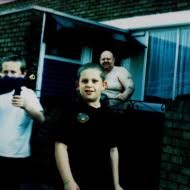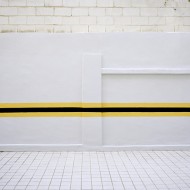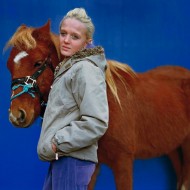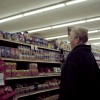Jack Radcliffe for years photographs in black and white the members of his family and his friends, gradually creating several series of photos that explore the long term evolution of the photographer relationship with his friends and relatives.
Here a selection of his works with an introduction to the subjects portrayed in each series and a description of the photographs he shoot at the York House Hospice in York, PA.
Following text and images by Jack Radcliffe.
Introduction
I have been making portraits of family, friends and acquaintances for the past 35 years. Early in my career, I discovered that the meaning of a single exposure, when it is part of a collection of moments, becomes only one element of an evolving story. Since the addition of each new portrait changes the meaning of the entire sequence, each image is no longer static. In every succeeding photograph, the subject and I are older, our circumstances have changed, and our relationship has deepened or dissolved. All of these forces are reflected in my photographs.
I am not a passive chronicler or documentary photographer. Whether the subject is my daughter, a local family, a former student, or a hospice patient, they are all in part autobiographical.
Dan
Daniel Van Allen, Selena and Spoon are at the center of Baltimore’s art underground. Dan lives in Sowebo (Southwest Baltimore), where he has connected two row houses creating a rabbit warren of a dwelling. His house is packed with such disparate artifacts as found objects, animal skeletons, coconut heads, and other objects from his trips to India and Mexico. All of these objects become a unified art installation which he calls Visionary Environment. His pet chicken, Chick-a-pea, lives in Daniel’s five connected backyards.
Hospice
As I photographed Barnie, I felt like such an intruder. I had to repeat myself, “These people want me to document this”.
I had mixed feelings when I was asked to participate in this project. I’m always excited about new opportunities, but I wasn’t sure how or if this fit into my work. When I began, I wasn’t really sure what hospice was. I only knew that it had to do with death. One of my students was a nurse. When I asked her about hospice, she put me in touch with Joy Ufema, founder of the York House Hospice in York, PA. I sent a letter to Joy and when she invited me to photograph at the hospice, I was extremely apprehensive. However, at this time in my life it was fortuitous. My mother had just died, and my father was dying. I wasn’t dealing at all with my loss. Being with Joy and the nurses at York House -seeing their devotion to patients, both physically and spiritually- helped me to view death as a part of life. It was a cathartic transformation for me, and eventually I was able to grieve for my parents as well as the patients I came to know.
In my previous work I was always striving for intimacy. In a way, this project forced me to achieve a new level of intimacy. At York House, I photographed over and over in the same three rooms. I wanted to reveal the relationship of my subjects to their environment. Soon I had to find new visual solutions to this problem. I changed my perspective and moved in closer to the patients. The relationship in turn has transformed my photographs.
“Although Jack Radcliffe’s pictures have a look of inevitability, as though they had composed themselves, in fact they are authoritatively crafted. Part of his technique relies on an insistent monumentality of composition, combined with a strong linear drive. His lens reaches right up into the gesture. Mass works in counterpoint with contour.
For instance, in each image of the handsome, long-limbed Sheila, the angles of her body and the objects around her, the strong diagonals and curves of each outline in the picture, build a structure emphasizing the key visual element of her and of the picture – her huge, expressive eyes. As we analyze each image, we discover that each employs this same principle of locating some very particular feature – whether a way of posing the arms or body, or a distinctive droop of the jaw – and intuitively presents that feature through artfully empathic, rather than psychologically confrontational, means”.
From Hospice: A Photographic Inquiry. Edited by Phillip Brookman, Jane Livingston and Dena Andre, copyright © 1996. A Bullfinch Press Book. Published by Little, Brown and Company: Boston, New York, Toronto, and London. In Association with the Corcoran Gallery of Art and the National Hospice Foundation.
Alison
My photographs of Alison, because of the nature of our relationship, are very much a father-daughter collaboration, Alison permitting me access to private moments of our life, which might, under different circumstances, be off-limits to a parent. The camera, early in her life, became part of our relationship, necessitating in me an acceptance, quietness. We’ve never had long photographic sessions, but rather moments alone or with friends.
Beppi
I began photographing Beppi and Stephen in 1992. They met while Beppi was in college studying art, married shortly after she graduated, and have since had three children, Gunnar, Ivana, and Strom. Beppi and Stephen share a passion for dress up. Beppi and Stephen admit they come from self-described dysfunctional families, which makes their strong marital bond, their desire for a large family, and the way they relate as husband and wife as well as mother and father, so compelling. Though unconventional in employment and pastimes, they have successfully built a traditional family structure.
Jen
I began a collaboration with Jenn with her daughter, Karma, in 2001. I was touched by the close bond between mother and daughter, and how they faced the challenges of single motherhood while living in subsidized housing.
In September of 2002, Jenn discovered that she was pregnant. We decided to celebrate the event by documenting every month throughout her pregnancy. I was honored to be the one man invited to attend the birth with ten women. Sage was born on June 26, 2003, at 6 p.m. I photographed the family regularly during Sage’s first year, culminating with her first birthday party.
Carole Jean
I first began photographing Carole Jean in the 1970s, when she lived in a primitive $35-a-month tenant farmhouse with her son and boyfriend. They were a self-sufficient household. There was an enormous vegetable garden for food, and they heated with wood. Carol Jean supported herself and her son, and without assistance from her family, earned an MFA.
Carole Jean lived the idyllic life of an artist; she painted, created mixed-media pieces, and photographed. Her paintings were colorful and fanciful, images inspired by her world travels, particularly to Oaxaca, Mexico. Her black and white and hand-colored photographs of elaborately costumed local children would have made Lewis Carroll envious.



































Hi, I have seen beautiful art in a dentist’s office that is signed carol jean.
One is a pond with fish and a lounging cat and is perhaps a courtyard with
plants and cactus. I am unable to find any examples of her work online at all …
do you know of any place where I can see more of her art and perhaps buy some?
Thank you!
Carole Jean is seriously ill. I’ll talk to her son if you’d like.
Jack
quite amazing. i especially like the last image (beppi)
You can also subscribe to this post comments RSS feed.